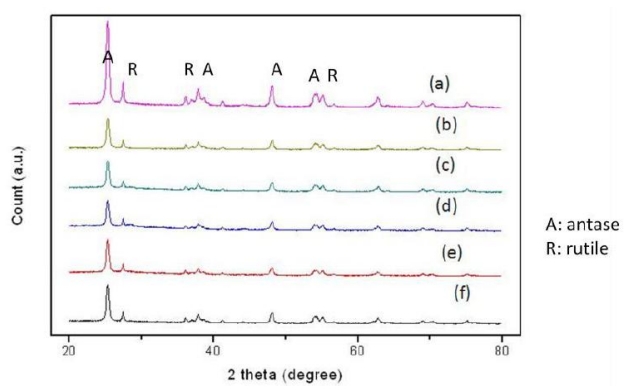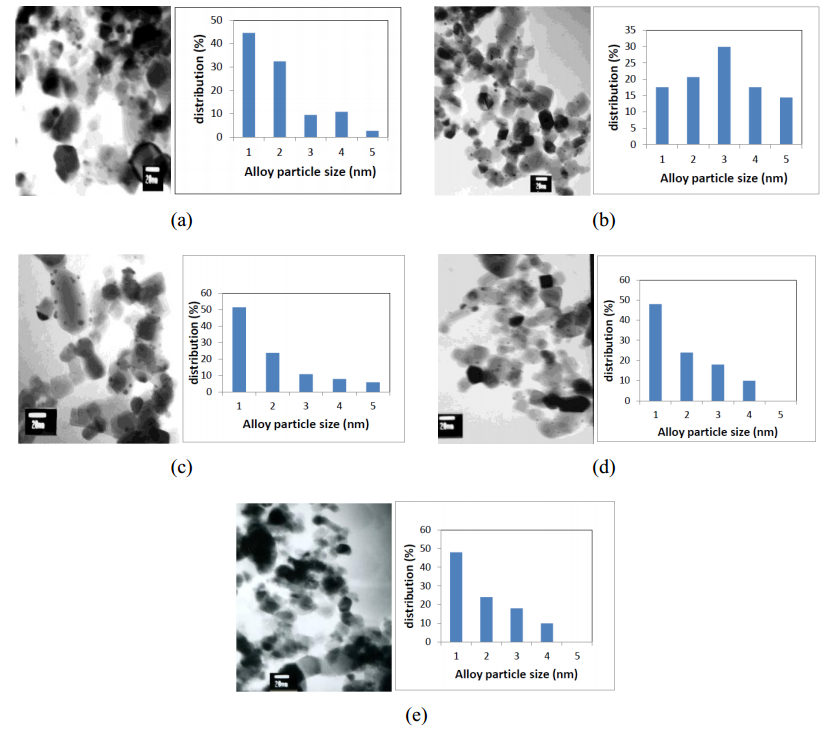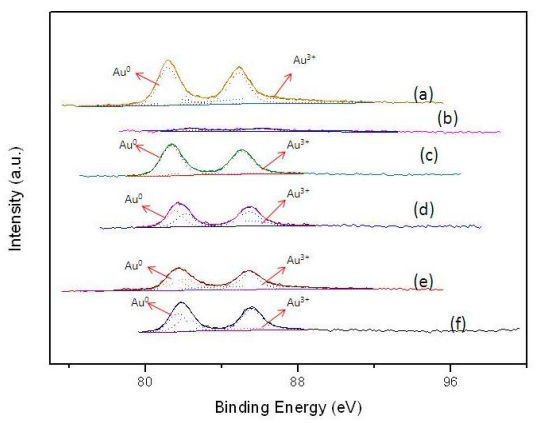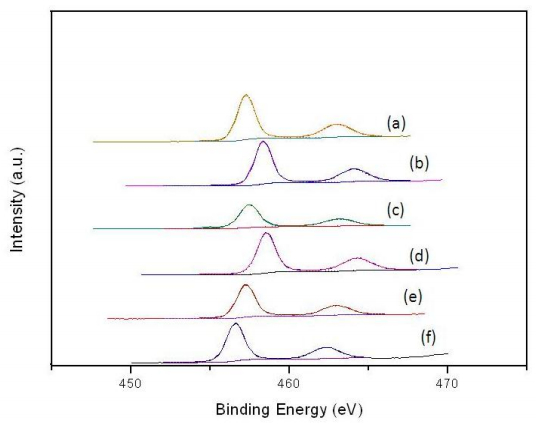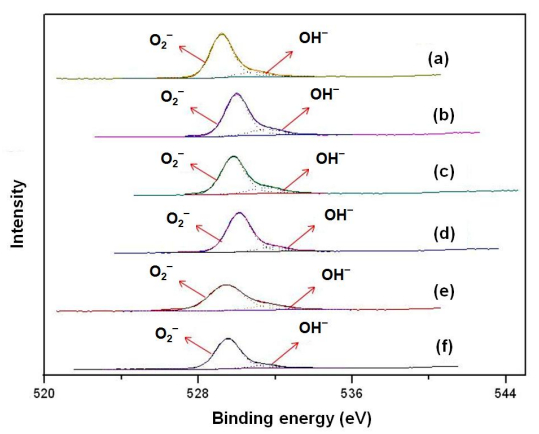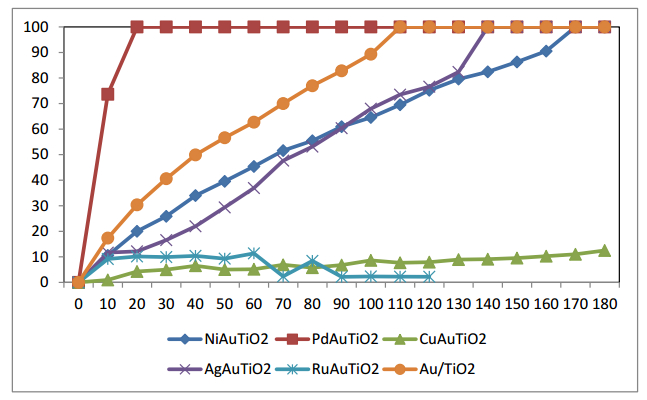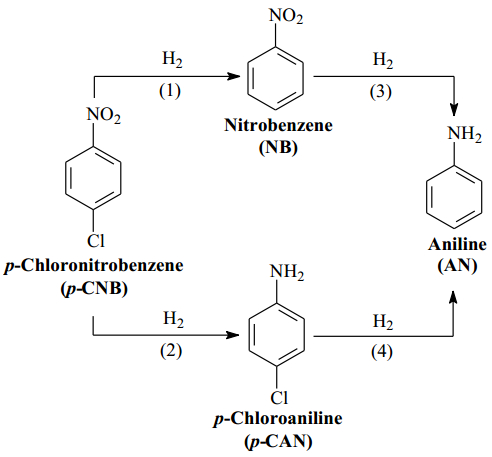1. Introduction
Since Bond et al. [1,2] studied the hydrogenation of olefins over supported gold catalyst and Haruta [3] successfully prepare gold nano-clusters on reducible support as a catalyst on the low temperature of oxidation CO reaction, nano-gold has been found to be a good catalyst in numerous reactions. Because of its superior ability of hydrogenation adsorption, gold catalyst has many potential advantages of competitive selectivity and activity on hydrogenation reactions [4,5,6,7,8,9,10,11,12,13,14,15,16,17,18,19,20,21,22,23,24,25,26,27,28,29,30,31]. Hydrogenation over gold catalysts exhibits structure sensitivity, where smaller particles (less than 10 nm) deliver higher activities. In other words, gold activates hydrogen, provide it is present as nano-sized particles, which are generally stabilized on a support [25,31,32,33,34,35]. Molecular hydrogen does not chemisorb on bulk gold [15] but weakly interacts at 78 K, desorbing with temperature at 125 K [36]. Instead, dissociative chemisorption of H2 occurs on low-coordinated Au sites, such as edges and corners [37].
Bimetallic nanoparticles with well-defined structures, compositions, and shapes have wide attention in catalysis study due to dramatically improved catalytic performances compared to monometallic nanoparticles [38,39,40,41]. There are two kinds of alloy effects: (1) geometric effects, i.e., a finite number of atoms in a particular geometric orientation that are required for facilitating a particular catalytic process; and (2) electronic effects, which involve charge transfer between the metals or orbital rehybridization of one or both metallic components. A significant development in catalysis for gold has seen the use of Au based alloys because it has fine selectivity and activity on reactions [42,43,44,45,46,47,48,49,50,51]. Bimetallic catalysts have attracted extensive attention because of their different properties from either of the constituent metals, and often enhanced catalytic stabilities, activities and/or selectivities. The addition of a second metal can favor the reduction of first, increase the dispersion of a metal which has a tendency to form large particles or decrease its fritting [43,44,45,46,47]. The gold-based bimetallic catalysts were applied on several reactions in industry because of its particular ability of product selectivity. For instance, Nutt et al. [46] used Pd–Au bimetallic nanoparticle catalysts for aqueous-phase trichloroethene hydrodechlorination reaction. Piccinini et al. [50] used direct synthesis of hydrogen peroxide by Au–Pd/TiO2 catalyst. Yuan et al. [52] studied Ni–Au alloy catalysts for application in catalytic hydrodechlorination. Cárdenas-Lizana et al. [31] used Au–Ni alloy catalysts on gas phase hydrogenation reaction. Au–Cu/TiO2 was used for partial oxidation of methanol reaction [53].
Hydrogenation of halonitroaromatics to the corresponding haloamines is a formidable challenge, which has several satisfactory solutions and has been industrialized on a large scale. Comparing with the traditional synthesis routes, the selective hydrogenation of halonitroaromatics to the corresponding haloamines was superior in saving resources, reducing the waste disposal and protecting the environment [54,55,56,57]. However, the hydrogenation of halonitrobenzene was very complex, and the overall reaction mechanism is shown in Scheme 1. The nitro group could be hydrogenated to amine group to produce p-chloroaniline (p-CAN) from the hydrogenation of p-chloronirobenzene (p-CNB). Then, it might be further hydrogenated to aniline (AN) and the chlorine atom might be eliminated in hydrogenation to form nitrobenzene (NB). Furthermore, NB could be hydrogenated to AN. In general, dechlorination could proceed in all reaction steps, especially, after reaching a stoichiometric consumption of hydrogen.
Regarding to the mechanism, the metal atoms existing on the surface of catalyst is favorable for the activation of polar N=O bond in –NO2 group, then the dissociated H atoms near the activated N=O bond attacks the N=O bond. Thus, the nitro group is reduced to –NH2 group. The weak interaction among metal, catalyst, and –NH2 will shorten the residence time on the surface of catalysts, so the dehalogenation of C–Cl bond is weakened [56]. It has been reported that the gas phase hydrogenation of p-chloronitrobenzene over Au supported on alumina and titania [31] was 100% selective in terms of –NO2 group reduction to p-chloroaniline over a prolonged (up to 80 h) time on-stream. However, the reaction condition in liquid phase is different from that in gas phase reaction.
The aim of this study was to prepare the gold-containing bimetallic catalysts which could be applied for p-CNB hydrogenation in liquid phase reaction. A series of M (Cu, Ni, Ag, Ru, Pd)–Au/TiO2 catalysts were prepared and tested. The catalysts were characterized by X-ray diffraction (XRD), transmission electron microscopy (TEM), and X-ray photoelectron spectroscopy (XPS).
2. Materials and Method
2.1. Chemicals
Reagents used in this study were analytical grade. TiO2 was purchased from Evonik (P-25). Pd(NO3)2 (Alfa Aesar, 99.9%) was used as the precursor for loading palladium by co-deposition-precipitation. HAuCl4 (Showa, 99.0%) was used as the precursor for loading gold by co-deposition-precipitation method. NH4OH (Showa) was used as neutralizers to adjust the pH value of preparation. Sodium borohydride (>98%) was purchased from Alfa Aesar. The reactant, p-chloronitrobenzene was from Acros (Belgium). High purity hydrogen gas (>99.99%) was derived from Air Product and used without any further purification.
2.2. Preparation of Catalysts
Bimetallic gold-containing cluster catalysts were prepared with different metal precursors on TiO2 support by co-deposition-precipitation method [58,59]. Au metal loading was fixed at 3 wt.%. The Au/M molar ratios of various catalysts are listed in Table 1. HAuCl4 solution and second metal precursor were prepared and dropped into the aqueous solution of TiO2 support under stirring. The temperature was maintained at 65 ℃, and the pH was adjusted to 7 with 1 M NH4OH. After aging for 2 h, NaBH4 solution was added into the aqueous solution and stirred for 10 min to reduce both metal cations. The precipitate was filtered and washed with hot water (65 ℃) until no Cl− was detected with AgNO3 solution. The filter cake was grounded and dried at 40 ℃ overnight.
Table 1. The Au/M ratio of bimetallic catalysts (Au loading was 3 wt.%).
| Catalyst |
Au/M (molar ratio) |
| Au/TiO2 |
|
| CuAu/TiO2 |
4:1 |
| RuAu/TiO2 |
3:1 |
| NiAu/TiO2 |
3:1 |
| AgAu/TiO2 |
3:1 |
| PdAu/TiO2 |
3:1 |
2.3. Characterization of Catalysts
The as-prepared samples were dried under the vacuum condition before carrying out the analysis of X-ray diffraction (XRD), transmission electron microscopy (TEM), and X-ray photoelectron spectroscopy (XPS).
2.3.1. XRD
The XRD instrument type was Siemens D500 powder diffractometer. The XRD patterns were collected by using Cu Kα1 radiation (0.15405 nm) at a tube voltage and current of 40 kV and 20 mA, respectively. The samples for XRD were prepared as thin layers on the sample holder and scanned over the range of 2θ = 20–70° at the rate of 0.05°·s−1 to identify the crystalline structure.
2.3.2. TEM
The morphologies and particle size of the samples were determined by TEM (Jeol JEM-2000 FX Ⅱ). The operation was at 120 kV. The TEM samples were prepared as following. A small amount of powder was put into the sample bottle filled with 99.8% methanol solvent. After agitating under ultrasonic environment for 90 min, one drop of the dispersed slurry was dipped onto a carbon coated copper mesh (300#; Ted Pella Inc., CA, USA) and dried in vacuum over night.
2.3.3. XPS
The XPS spectra were recorded with a Thermo VG Scientific Sigma Probe spectrometer. The XPS spectra were collected by using Al Kα radiation at a voltage and current of 20 kV and 30 mA respectively. The base pressure in the analyzing chamber was maintained in the order of 10−9 torr and the spectrometer was operated at 23.5 eV pass energy. The sample was sputtered using Ar+ ions for 15 min to remove the oxidation parts which were formed during the XPS operation. All the binding energies were calibrated by using the contaminant carbon (C 1s = 284.5 eV). Peak fitting was done by using the software, XPSPEAK 4.1 with Shirley background, 30:70 Lorentzian to Gaussian convolution product shapes.
2.4. Hydrogenation Reaction
The catalytic activities and selectivities of the samples were tested by the liquid-phase hydrogenation of p-CNB. All the experiments were carried out in the cylindrical stirred-tank reactor (Parr Instrument Model 4842) with 160 mL capacity. A four-bladed pitched impeller was placed for effective agitation and the agitator was connected to an electric motor with variable speed which was up to 1700 rpm. A pressure transmitter and an automatic temperature controller were also provided. The gases were supplied from cylinders and introduced to the base of reactor. The reactor was charged by 0.5 g catalyst and 2.54 g p-CNB in 80 mL methanol solvent, the concentration of p-CNB was 0.2 M. In the beginning, air was flushed out of the reactor by hydrogen at room temperature. After the designated temperature was reached, hydrogen was fed to reach the preset pressure and the stirring speed was fixed at 500 rpm. These conditions were maintained throughout the reaction, defining this point as time zero. During the reaction run, the samples were withdrawn periodically and analyzed by a gas chromatograph equipped with a flame ionization detector and a 3 m × 1/8 inch stainless steel column packed with 5% OV-101 on Chromsorb WAW-DMSC (80–100 mesh). The experiments have been repeated twice at least and the reproducibility was above 98%.
The conversion and the selectivity to each product were calculated as following:
|
Conversion(%)=(1−Cp−CNBCAN+CNB+Cp−CAN+Cp−CNB)×100%
|
(1)
|
|
SAN(%)=(CANCAN+CNB+Cp−CAN)×100%
|
(2)
|
|
SNB(%)=(CNBCAN+CNB+Cp−CAN)×100%
|
(3)
|
|
Sp−CAN(%)=(Cp−CANCAN+CNB+Cp−CAN)×100%
|
(4)
|
where CAN, CNB, Cp-CAN and Cp-CNB represented the concentrations of aniline, nitrobenzene, p-chloroaniline and p-chloronitrobenzene, respectively.
3. Results and Discussion
3.1. XRD
The XRD patterns of gold-containing bimetallic catalysts are shown in Figure 1. These catalysts only showed intense TiO2 peaks, including anatase phase at 2θ = 25.06° (101), 38.14° (004), 48.03° (200) and 54.15° (105) and rutile phase 2θ = 27.50° (110), 36.11° (101), and 55.18° (211), as expected since TiO2 was from Evonik P-25. No distinct gold peaks at 2θ = 38.2° and 44.5° and no other metal peaks were observed, since the gold-containing bimetallic cluster size was too small to detect. This confirms that the size of bimetallic clusters were less than 4 nm.
3.2. TEM
The TEM images of gold-containing bimetallic catalysts are shown in Figure 2. One can see that there were many small bimetallic particles in each sample, and the average particle size was 2.0–3.5 nm. The average particle size, dparticle, was calculated using the following equation: dparticle = Σnidii3/Σnidi2, where ni is the number of particles of diameter dparticle. The particle size of TiO2 P-25 from Evonik was in the range of 20–40 nm. The sizes of gold-containing bimetallic particles were around 2–4 nm as shown in Table 2. The results are in agreement with XRD results. There is no significant difference among all samples, indicating that the co-deposition-precipitation method can be used to prepare bimetallic clusters on TiO2 support.
Table 2. Average sizes of gold-containing bimetallic particles.
| Sample |
Average size (nm) |
| Au/TiO2 |
3.3 |
| CuAu/TiO2 |
2.9 |
| RuAu/TiO2 |
1.9 |
| NiAu/TiO2 |
2.0 |
| AgAu/TiO2 |
2.7 |
| PdAu/TiO2 |
2.1 |
3.3. XPS
The compositions and electronic state of each species on the surface of the samples were determined by XPS analysis. All metals were deposited on TiO2 support. Since the isoelectric point of TiO2 is around 8, so the pH value during deposition precipitation process should be lower than 8. If the pH value is too high, the particle size would be big. If the pH value is too low, only very small amount of metal would deposit on the support. Therefore the pH value was controlled at 7 in this study. The temperature was controlled at 65 ℃.
The XPS spectra of Au 4f, Ti 2p and O 1s in the different bimetallic catalysts are shown in Figures 3–5. The XPS spectra for all the catalysts suggest that Au species existed in different states as metallic gold (Au0) and Au3+. Au 4f was characterized by the doublet of two spin orbit components, viz., Au 4f7/2 and Au 4f5/2 [51]. The peaks for metallic gold located at 84.0 eV (Au 4f7/2) and 87.7 eV (Au 4f5/2). The peaks for Au3+ were centered at 86.3 eV (Au 4f7/2) and 89.6 eV (Au 4f5/2). The Ti 2p XPS spectrum was deconvoluted into four peaks, which Ti 2p3/2 at 455 ± 0.3 eV is indicative as Ti2+, whereas Ti 2p3/2 at 459 eV is indicative as Ti4+. It should be noted that all bimetals were alloy with nano size. In the nanosize range, the surface concentrations were different among various samples. Cu, Ag, Ru, and Pd would form nano-alloy with Au [60,61,62,63,64]. In addition, Cu–Au, Ag–Au, and Ru–Au alloy would have Cu-, Ag-, and Ru-enriched surface, respectively [62,63,64]. Instead, Pd–Au alloy would have Pd-enriched surface [60,61]. There are two kinds of alloy effects: (1) geometric effects, i.e., the surface-enriched metal would change the distance of Au–Au atoms that is required for facilitating the hydrogenation of chloronitrobenzene; and (2) electronic effects, which involve charge transfer between the metals.
The O 1s XPS spectrum was deconvoluted into two peaks as shown in Figure 5. The O 1s peak at ~529 eV was indicative of metal oxides (O2−), whereas the peak at ~531 eV was indicative of hydroxides (OH−). As shown in Figure 5, the peak of Au show that only PdAu/TiO2 had positive shift, and other bimetallic Au peaks had negative shift. This result indicates that each different metal interacted with gold in different ways. In this series of catalysts, the Ti 2p peaks were only existed as Ti4+ peaks as shown in Figure 4. The O 1s peaks of all the samples showed a few amount of OH− in Figure 5 and Table 3.
Table 3. Analysis of the binding energy of the species on the surface of the catalyst.
| catalyst |
Au 4f7/2 |
|
Ti 2p3/2 |
|
O 1s |
| Au0 (eV) |
Au3+ (eV) |
Ti2+ (eV) |
Ti4+ (eV) |
O2− (eV) |
OH− (eV) |
| Au/TiO2 |
84.88 |
85.74 |
|
|
457.25 |
|
529.20 |
530.81 |
| AgAu/TiO2 |
81.53 |
82.10 |
|
458.34 |
529.98 |
531.54 |
| NiAu/TiO2 |
81.699 |
82.14 |
|
456.58 |
529.8 |
531.49 |
| CuAu/TiO2 |
81.36 |
82.29 |
|
457.24 |
529.53 |
531.38 |
| RuAu/TiO2 |
82.33 |
84.03 |
|
458.53 |
530.11 |
531.85 |
| PdAu/TiO2 |
85.40 |
85.44 |
|
457.44 |
529.44 |
531.66 |
Table 3 lists the binding energies of various species of M–Au/TiO2 catalysts. The Au binding energy shifted negatively in AgAu/TiO2, NiAu/TiO2, RuAu/TiO2, and CuAu/TiO2, whereas Au binding energy shifted positively only in PdAu/TiO2. The Ti 2p peaks had some negative shift from 459 eV. However, the binding energy of O 1s peak did not show obviously shift. The chemical compositions of Au, Ti and O on surface of each sample are tabulated in Table 4. Besides, the widths of the Au peaks in bimetallic samples were broader than that of monometallic one, due to the interactive effect of gold and second metal.
Table 4. Analysis of the compositions of the species on the surface of the catalyst.
| catalyst |
Au 4f7/2 |
|
Ti 2p3/2 |
|
O 1s |
| Au0 (%) |
Au3+ (%) |
Ti2+ (%) |
Ti4+ (%) |
O2− (%) |
OH− (%) |
| Au/TiO2 |
65.71 |
34.29 |
|
|
100 |
|
88.39 |
11.61 |
| AgAu/TiO2 |
59.26 |
40.74 |
|
100 |
84.51 |
15.49 |
| NiAu/TiO2 |
38.39 |
61.61 |
|
100 |
83.65 |
16.35 |
| CuAu/TiO2 |
89.5 |
10.5 |
|
100 |
91.84 |
8.16 |
| RuAu/TiO2 |
46.35 |
53.65 |
|
100 |
89.6 |
10.4 |
| PdAu/TiO2 |
49.91 |
50.09 |
|
100 |
85.52 |
14.48 |
Comparing with monometallic gold on TiO2, the peaks of Au in bimetallic samples had 0.2–0.3 eV shift as shown in Figure 3. According to the literature [65], the shift of Au peaks is due to the second metal interacting with Au and become partial surface alloy formation. In this series of bimetallic catalyst, the second metal became partial oxidation (M → Mn+) as induced by gold.
3.4. Hydrogenation Reaction
The conversion of p-CNB vs. reaction time on stream over various catalysts is shown in Figure 6. The main product of p-CNB hydrogenation was p-CAN and there were two by-products, NB and AN. In each case, the concentration of NB and AN increased in the initial period, then NB decreased and p-CAN and AN increased. The reaction scheme can be simplified to scheme 2. There are two interpretations for these results: one is that the rate of hydrogenation carried on the path (1) is faster than that of path (3); another is that p-CNB mainly followed path (1) then path (2), but less path (3) and path (4). However, the increasing rate of aniline was not obvious, so the possibility of the first case was low.
The reaction was first order with respect to the concentration of p-CNB. As shown in Figure 6, the activity of PdAu/TiO2 catalyst showed better performance than the other catalysts. In the gold-based bimetallic catalysts, PdAu/TiO2 had the highest reaction rate, its conversion of p-CNB reached 100% within 20 min. The activities of the catalysts decreased in the following order: PdAu/TiO2 > Au/TiO2 > NiAu/TiO2 > AgAu/TiO2 > RuAu/TiO2 > CuAu/TiO2 as shown in Figure 6. It could be concluded that Pd and Au mixed as nano-alloy and Pd modified gold to become a very active site on the catalyst for hydrogenation of p-CNB. Although the selectivity of p-CAN on PdAu/TiO2 was lower than other catalysts, the yield of p-CAN on PdAu/TiO2 was higher than other catalysts since its activity was much higher than other samples.
Based on the electronic effect, both –NO2 and –Cl adsorb strongly on electron-rich metal, which would result in higher activity in the hydrogenation of the nitro group and dechlorination. There are two highly electronegative elements, N and O existing in the nitro group. Oxygen atom is more electronegative than nitrogen atom; hence, the N–O bond is polarized. The partially positive charge of nitrogen atom, combined with high electronegativity, led to the nitro group being easily reduced. Because of the combination of inductive and resonance effects, the para-substituted nitro group has high electronegativity. About chorine, only the inductive effect is present. Since the –NO2 group is more electronegative than –Cl, –NO2 is supposed to occupy the active site on the gold particles at the start of the reaction. Owing to the chemical bonding in the nitro group, the nitrogen atom is positively charged and each oxygen atom has a partial negative charge, and the nitro group strongly attracts electrons. For this reason the TiO2 as a support has great ability of donating electron to gold, the gold on the surface becomes more electron-enriched. Moreover, the different metal mixed with gold could reduce gold and form gold-based nano-alloy particles. The high electronegativity of –NO2 would be adsorbed on electron-enrich gold, which would result in higher activity in the hydrogenation of the nitro group and dechlorination. The electron density of PdAu/TiO2 was higher than those of other catalysts, which could lead into higher reaction activity. In the hydrogenation of p-CNB, since part of electron transferred to gold facilitated the catalyst attracting the partial negative oxygen easily so the N=O bond of –NO2group was activated, and the hydrogen could attack the partial positive nitrogen easily.
3.5. Reaction Rate Constant
The hydrogenation reaction rate constant was calculated for all gold catalysts. Based on the conversion-time curves in the hydrogenation of p-CNB (Figure 6), it indicates that the reaction was first order with respect to the concentration of p-CNB. The reaction rate can be expressed as following:
where k is reaction rate constant, s−1; CA0 is the initial concentration of reactant; and XA is conversion, %. The reaction was carried out in a constant-volume batch reactor, so:
where t is reaction time, s. Combined these two equations by using integral method of analysis of data, one could get:
A plot of −ln(1 − XA) vs. t could derive the slope which represents the reaction rate constant. Because of the induction period appeared in the initial stage of reaction, the data in initial stage was neglected. The results are listed in Table 5. As expected, the rate constant of PdAu/TiO2 was the highest among all catalysts in this study.
Table 5. Effect of additive on the hydrogenation of p-CNB over M–Au/TiO2.
| catalysts |
Conversion (%) |
Selectivity (%) |
reaction rate constant (s−1) |
reaction rate: [mol p-CNB/ (g metal × s)] |
reaction rate [mol p-CNB/ (mol metal × s)] |
| p-CAN |
AN |
NB |
| NiAu/TiO2 |
100 |
98.92 |
0.96 |
0.12 |
0.0086 |
0.00017 |
0.0275 |
| PdAu/TiO2 |
100 |
84.01 |
15.99 |
0 |
0.1344 |
0.001524 |
0.265 |
| CuAu/TiO2 |
12.5 |
92.33 |
0 |
7.67 |
0.0008 |
0.000034 |
0.0057 |
| AgAu/TiO2 |
100 |
100 |
0 |
0 |
0.0112 |
0.000177 |
0.0308 |
| RuAu/TiO2 |
2.2 |
0 |
0 |
100 |
0.0045 |
0.00014 |
0.0242 |
4. Conclusion
A series of gold-based bimetallic catalysts were prepared by co-deposition-precipitation method, where the second metals were Ag, Ru, Ni, Pd, and Cu, respectively. They were characterized by X-ray diffraction, transmission electron microscopy and X-ray photoelectron spectroscopy. The catalytic properties of the catalysts were tested by the liquid phase hydrogenation of p-CNB at 373 K and 1.1 MPa H2 pressure.
No distinct metal XRD peaks were observed because the metal particles were too small to detect, and only the peaks of TiO2 were found. The TEM images showed that the average gold-metal alloy particle size were less than 4 nm, in consistent with the XRD results. Using deposition-precipitation method, one was successfully prepare alloy-cluster on TiO2 support. The XPS spectra showed the gold peaks shifted in various samples, depending on the species of second metal. Only the Au peak in PdAu/TiO2 shifted positively. The Au peaks in other samples had negative shift. Furthermore, the width of gold peaks became broader owing to the formation of gold-based alloy particles. Au was enriched on the surface of Pd–Au particles. Ni–Au, Cu–Au, Ag–Au and Ru–Au had different behavior, i.e., the second metals were surface-enriched on these samples. Both ensemble and electronic effects of alloy clusters modified the catalytic performance of the catalysts, resulting in different activity and selectivity in hydrogenation of p-CNB to p-CAN. The activity decreased in the following order: PdAu/TiO2 > Au/TiO2 > NiAu/TiO2 > AgAu/TiO2 > RuAu/TiO2 > CuAu/TiO2. PdAu/TiO2 had the highest reaction rate among all catalysts, its conversion of p-CNB reached 100% within 20 min.
Conflict of Interest
The authors declare that there is no conflict of interest.









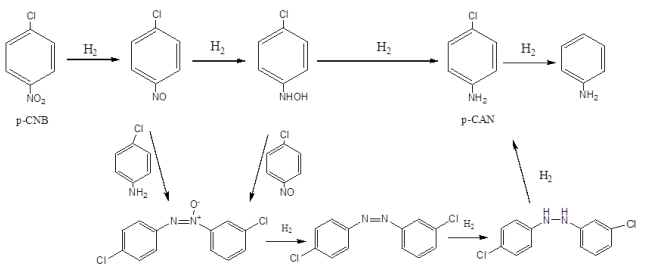
 DownLoad:
DownLoad: 